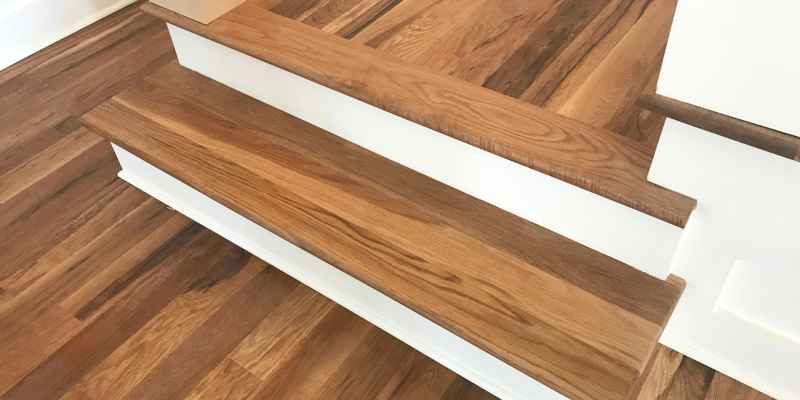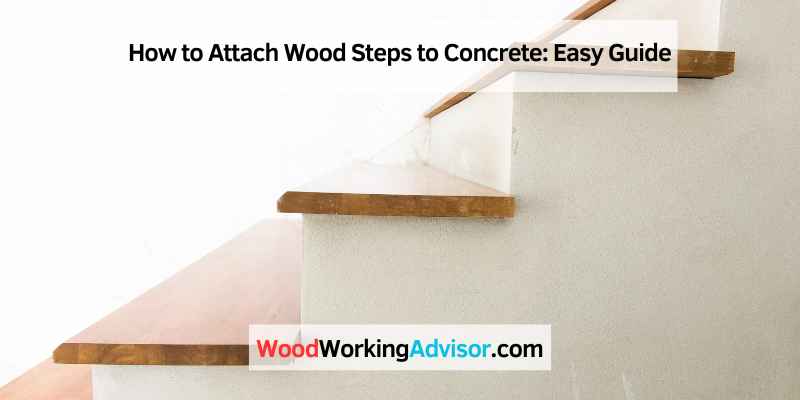To attach wood steps to concrete, use a hammer drill and concrete screws for secure installation. Pre-drill holes for screws.
When adding wood steps to your concrete space, it is essential to ensure a secure attachment for safety and durability. By following the proper steps and utilizing the right tools, you can create a sturdy and reliable set of wooden steps that will enhance the aesthetic appeal of your property.
In this guide, we will discuss the steps required to attach wood steps to concrete effectively. Let’s delve into the process of securely and efficiently installing wood steps on a concrete surface.
Introduction To Attaching Wood Steps To Concrete
Learn how to securely attach wood steps to concrete by using anchor bolts and construction adhesive. This method ensures stability and durability, creating a safe and long-lasting staircase for your outdoor space. Following these steps will help you achieve a secure and reliable wood-to-concrete attachment.
When it comes to enhancing the aesthetic appeal and functionality of your outdoor space, wooden steps can be a fantastic addition. Whether you’re looking to create a pathway to your front door or build a staircase leading to a patio or deck, attaching wood steps to concrete is a secure and reliable method. By securely fastening the steps to the concrete surface, you can ensure durability and stability, providing a safe and visually appealing solution for your outdoor stairs.
Importance Of Secure Attachment
Securing wood steps to concrete is crucial for several reasons. Firstly, it ensures the stability and safety of the steps, preventing any wobbling or shifting that could lead to accidents. Secondly, a secure attachment prevents the wood from rotting or decaying due to moisture trapped between the step and the concrete surface. Additionally, a strong connection between the wood and concrete can withstand heavy foot traffic, making it a long-lasting solution for your outdoor stairs.
Benefits Of Wood Steps
Wood steps offer numerous advantages, making them a popular choice for outdoor staircases. Here are some of the benefits:
- Aesthetics: Wood steps add warmth and natural beauty to any outdoor space, complementing various architectural styles.
- Versatility: Wood is a versatile material that can be customized to match your desired design, whether it’s a rustic look or a modern aesthetic.
- Comfort: Wood provides a comfortable surface to walk on, offering a softer and more forgiving feel compared to concrete or metal.
- Insulation: Wood acts as a natural insulator, helping to keep the steps cooler in hot weather and warmer in colder temperatures.
- Durability: With proper maintenance, wood steps can withstand the elements and last for many years, providing excellent long-term value.
By attaching wood steps securely to concrete, you can enjoy all these benefits while ensuring a sturdy and reliable staircase for your outdoor space.
Materials And Tools Required
When attaching wood steps to concrete, it’s essential to have the right materials and tools on hand to ensure a secure and durable installation. Before starting the project, gather the necessary items to streamline the process and minimize interruptions.
List Of Materials
- Pressure-treated wood steps
- Concrete screws or anchors
- Construction adhesive
- Wood sealer or paint
- Concrete cleaner
- Waterproofing membrane
- Wood shims
- Plastic sheeting
- Protective gloves
Tools For The Job
- Drill with masonry bit
- Hammer drill (if needed)
- Circular saw
- Level
- Tape measure
- Chalk line
- Paintbrush or roller
- Broom
- Bucket and scrub brush
Preparation Steps
When it comes to attaching wood steps to concrete, preparation is key to ensure a secure and long-lasting installation. The preparation steps involve measuring and planning, as well as preparing the concrete surface to create a solid foundation for the wood steps.
Measuring And Planning
Before starting the attachment process, it’s essential to measure the area where the wood steps will be attached and carefully plan the layout. Accurate measurements and a well-thought-out plan will ensure that the steps are positioned correctly and securely anchored to the concrete surface.
Preparing The Concrete Surface
Preparing the concrete surface is crucial for the successful attachment of wood steps. This involves cleaning the concrete thoroughly to remove any dirt, debris, or grease that could affect the adhesion. Using a wire brush and a concrete cleaner can help to achieve a clean and smooth surface, free from any obstacles that could interfere with the attachment process.
Selecting The Right Wood
Selecting the right wood is crucial when attaching wood steps to concrete. The wood should be pressure-treated to prevent rotting and decay. Additionally, it should be strong enough to support the weight of the steps and foot traffic.
When it comes to attaching wood steps to concrete, selecting the right wood is crucial for durability and safety. In this section, we will discuss the types of wood to use and how to treat them for maximum durability.
Types Of Wood To Use
Choosing the right type of wood for your concrete steps depends on various factors such as climate, budget, and personal preference. Here are some of the most commonly used wood types for attaching wood steps to concrete:
| Wood Type | Pros | Cons |
|---|---|---|
| Cedar | Durable, resistant to rot and insects, visually appealing | Expensive, may splinter or warp over time |
| Redwood | Durable, naturally insect and rot-resistant, visually appealing | Expensive, may split or warp over time |
| Pressure-treated Pine | Relatively inexpensive, durable, resistant to rot and insects | May warp or crack over time, contains chemicals that may be harmful |
| Ipe | Extremely durable, resistant to rot and insects, visually appealing | Very expensive, difficult to work with, requires special tools and hardware |
Treating Wood For Durability
Regardless of the type of wood you choose, it is essential to treat it properly to ensure maximum durability. Here are some tips for treating wood for attaching wood steps to concrete:
- Apply a water-repellent sealer to protect the wood from moisture.
- Use a wood preservative to prevent rot and insect damage.
- Apply a UV-resistant stain or paint to protect the wood from sun damage.
- Make sure to sand the wood to remove any rough edges or splinters that could cause injury.
By following these tips for selecting and treating the right wood, you can ensure that your wood steps attached to concrete will be durable, safe, and visually appealing for years to come.
Mounting The Wood Steps
To attach wood steps to concrete, start by measuring and marking the positions for the steps. Then, use a hammer drill to create holes in the concrete for the anchor bolts. Next, position the wood steps and secure them in place with the anchor bolts, ensuring they are level and secure.
Cutting Wood To Size
Cut wood to match the dimensions.
Drilling Into Concrete
- Use masonry bit and drill.
- Drill holes for each step.
- Insert anchors for stability.
Securing The Steps

To attach wood steps to concrete, start by drilling holes in the concrete, then use concrete anchors to secure the wood steps in place. Next, attach the wood steps to the concrete using screws or bolts, ensuring a strong and stable connection.
This method provides a secure foundation for the wood steps and ensures safety for anyone using them.
Securing the Steps is an essential part of attaching wood steps to concrete. Anchoring steps to concrete is the first step towards ensuring stability and alignment. In this section, we will discuss how to anchor the steps to concrete and how to ensure that they are stable and aligned.
Anchoring Steps To Concrete
To anchor the steps to concrete, you will need concrete anchors. Here are the steps to follow:
- Mark the location of the steps on the concrete with a chalk line.
- Drill holes into the concrete using a masonry bit. The holes should be slightly smaller than the diameter of the anchors.
- Insert the anchors into the holes and tap them in with a hammer until they are flush with the surface of the concrete.
- Place the step on top of the anchors and drill pilot holes through the holes in the step and into the anchors.
- Screw the step onto the anchors using concrete screws.
Ensuring Stability And Alignment
Once the steps are anchored to the concrete, it’s important to ensure that they are stable and aligned. Here are some tips:
- Use a level to ensure that the steps are level from side to side and front to back.
- If the steps are not level, use shims to adjust them until they are.
- Use a square to ensure that the steps are square to the house or other structure they are attached to.
- If the steps are not square, adjust them until they are.
- Secure the steps to the structure they are attached to using brackets or other hardware to prevent them from shifting.
In conclusion, securing the steps is crucial for the safety and stability of the structure. By anchoring the steps to the concrete and ensuring they are level and square, you can create a solid and safe set of steps that will last for years to come.
Finishing Touches
When attaching wood steps to concrete, ensuring the finishing touches are done correctly is vital. Here are two crucial steps to complete the process:
Sealing And Protecting Wood
To protect the wood from weather damage, apply a wood sealant after attaching the steps. This will prevent moisture penetration and extend the lifespan of the wood.
Adding Non-slip Surfaces
To enhance safety, consider adding non-slip surfaces to the wood steps. Options include non-slip adhesive strips, anti-slip coatings, or rubber mats.
Maintenance And Care
Learn how to securely attach wood steps to concrete with these easy-to-follow tips. By following the proper procedure, you can ensure the steps are sturdy and safe for use. Get step-by-step instructions on how to complete this maintenance task effectively.
Regular Maintenance Tips
Regularly inspect wooden steps for cracks or damage.
Clean steps using a mild detergent and water.
- Remove debris and dirt.
- Sweep regularly to prevent buildup.
Troubleshooting Common Issues
If steps become slippery, apply anti-slip tape.
Repair any cracks or loose screws promptly.
- Check for rot or mold.
- Stain steps every 1-2 years for protection.
Safety Precautions
When attaching wood steps to concrete, it is crucial to prioritize safety precautions. Start by ensuring the concrete surface is clean and free from debris. Next, use the appropriate anchors to securely fasten the wood steps to the concrete, providing a stable and safe structure for use.
Safety During Installation
During the installation process, it is important to prioritize safety to avoid accidents or injuries. Here are some safety precautions to keep in mind when attaching wood steps to concrete:
- Wear protective gear like gloves, goggles, and a dust mask to protect yourself from debris and dust.
- Ensure that the work area is well-lit and free of clutter to prevent tripping or slipping.
- Use a level to make sure that the steps are installed evenly and securely.
- Use a drill with a masonry bit to make holes in the concrete and a wood bit to make holes in the wood. Make sure to use the appropriate bits to avoid damaging the materials.
- Have a partner to assist you in holding the wood steps in place while installing them.
Long-term Safety Considerations
Aside from ensuring safety during installation, it is also important to consider long-term safety when attaching wood steps to concrete. Here are some things to keep in mind:
- Regularly check the steps for any signs of damage or wear and tear. Replace any damaged or rotting wood immediately.
- Apply a non-slip coating or adhesive strips to the steps to prevent slipping, especially during wet or rainy weather.
- Regularly clean the steps to prevent the buildup of dirt and debris, which can make the steps slippery and dangerous.
- Consider installing handrails or guardrails for added safety, especially if the steps are high or steep.
By following these safety precautions and considering long-term safety, you can ensure that your wood steps are securely attached to your concrete surface, while keeping yourself and others safe.

Frequently Asked Questions
How Do You Attach Wood Steps To Concrete?
To attach wood steps to concrete, start by measuring and marking the placement, then drill holes and insert concrete anchors. Secure the wood steps to the concrete using screws, ensuring a strong and stable attachment.
What Tools Are Needed To Attach Wood Steps To Concrete?
You will need a hammer drill, concrete anchors, screws, a tape measure, a pencil, and a screwdriver. These tools will help you accurately and securely attach the wood steps to the concrete surface.
Can Wood Steps Be Attached To Any Type Of Concrete?
Yes, wood steps can be attached to various types of concrete surfaces, including concrete stairs, patios, and walkways. It’s important to use the appropriate tools and techniques to ensure a secure and durable attachment.
What Are The Advantages Of Attaching Wood Steps To Concrete?
Attaching wood steps to concrete provides a natural and aesthetically pleasing look. It also offers stability and durability, making it a practical and long-lasting solution for enhancing the appearance and functionality of outdoor spaces.
Conclusion
Attaching wood steps to concrete can be a straightforward process if you follow the right steps. By preparing the concrete surface, selecting the appropriate hardware, and using the correct tools, you can ensure a secure and long-lasting attachment. Remember to take safety precautions and seek professional assistance if needed.
With these guidelines, you’ll be able to enhance your outdoor space with sturdy and visually appealing wooden steps. Happy DIY-ing!


